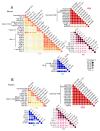Proteomic Analysis of Histone Variants and Their PTMs: Strategies and Pitfalls
- PMID: 29933573
- PMCID: PMC6161106
- DOI: 10.3390/proteomes6030029
Proteomic Analysis of Histone Variants and Their PTMs: Strategies and Pitfalls
Abstract
Epigenetic modifications contribute to the determination of cell fate and differentiation. The molecular mechanisms underlying histone variants and post-translational modifications (PTMs) have been studied in the contexts of development, differentiation, and disease. Antibody-based assays have classically been used to target PTMs, but these approaches fail to reveal combinatorial patterns of modifications. In addition, some histone variants are so similar to canonical histones that antibodies have difficulty distinguishing between these isoforms. Mass spectrometry (MS) has progressively developed as a powerful technology for the study of histone variants and their PTMs. Indeed, MS analyses highlighted exquisitely complex combinations of PTMs, suggesting “crosstalk” between them, and also revealed that PTM patterns are often variant-specific. Even though the sensitivity and acquisition speed of MS instruments have considerably increased alongside the development of computational tools for the study of multiple PTMs, it remains challenging to correctly describe the landscape of histone PTMs, and in particular to confidently assign modifications to specific amino acids. Here, we provide an inventory of MS-based strategies and of the pitfalls inherent to histone PTM and variant characterization, while stressing the complex interplay between PTMs and histone sequence variations. We will particularly illustrate the roles played by MS-based analyses in identifying and quantifying histone variants and modifications.
Keywords: bottom-up analysis; computational tools; crosstalk; histone variants; mass spectrometry; post-translational modifications.
Conflict of interest statement
None of the authors have any conflict of interest to declare.
Figures





Similar articles
-
The top-down, middle-down, and bottom-up mass spectrometry approaches for characterization of histone variants and their post-translational modifications.Proteomics. 2014 Mar;14(4-5):489-97. doi: 10.1002/pmic.201300256. Epub 2013 Dec 16. Proteomics. 2014. PMID: 24339419 Review.
-
Histone Purification Combined with High-Resolution Mass Spectrometry to Examine Histone Post-Translational Modifications and Histone Variants in Caenorhabditis elegans.Curr Protoc Protein Sci. 2020 Dec;102(1):e114. doi: 10.1002/cpps.114. Curr Protoc Protein Sci. 2020. PMID: 32997895 Free PMC article.
-
Visualization of the dynamics of histone modifications and their crosstalk using PTM-CrossTalkMapper.Methods. 2020 Dec 1;184:78-85. doi: 10.1016/j.ymeth.2020.01.012. Epub 2020 Jan 21. Methods. 2020. PMID: 31978537
-
Quantitative analysis of post-translational modifications of histone H3 variants during the cell cycle.Anal Chim Acta. 2019 Nov 8;1080:116-126. doi: 10.1016/j.aca.2019.06.028. Epub 2019 Jun 12. Anal Chim Acta. 2019. PMID: 31409460
-
Histone variant-specific post-translational modifications.Semin Cell Dev Biol. 2023 Feb 15;135:73-84. doi: 10.1016/j.semcdb.2022.02.012. Epub 2022 Mar 9. Semin Cell Dev Biol. 2023. PMID: 35277331 Free PMC article. Review.
Cited by
-
Decoding the mechanism of hypertension through multiomics profiling.J Hum Hypertens. 2023 Apr;37(4):253-264. doi: 10.1038/s41371-022-00769-8. Epub 2022 Nov 3. J Hum Hypertens. 2023. PMID: 36329155 Free PMC article. Review.
-
Trimethylacetic Anhydride-Based Derivatization Facilitates Quantification of Histone Marks at the MS1 Level.Mol Cell Proteomics. 2021;20:100114. doi: 10.1016/j.mcpro.2021.100114. Epub 2021 Jun 12. Mol Cell Proteomics. 2021. PMID: 34129942 Free PMC article.
-
Dynamic acylome reveals metabolite driven modifications in Syntrophomonas wolfei.Front Microbiol. 2022 Nov 7;13:1018220. doi: 10.3389/fmicb.2022.1018220. eCollection 2022. Front Microbiol. 2022. PMID: 36419437 Free PMC article.
-
Filter-Aided Sample Preparation Procedure for Mass Spectrometric Analysis of Plant Histones.Front Plant Sci. 2018 Sep 19;9:1373. doi: 10.3389/fpls.2018.01373. eCollection 2018. Front Plant Sci. 2018. PMID: 30283482 Free PMC article.
-
Ubiquitination and Ubiquitin-Like Modifications in Multiple Myeloma: Biology and Therapy.Cancers (Basel). 2020 Dec 14;12(12):3764. doi: 10.3390/cancers12123764. Cancers (Basel). 2020. PMID: 33327527 Free PMC article. Review.
References
Publication types
LinkOut - more resources
Full Text Sources
Other Literature Sources
Miscellaneous

